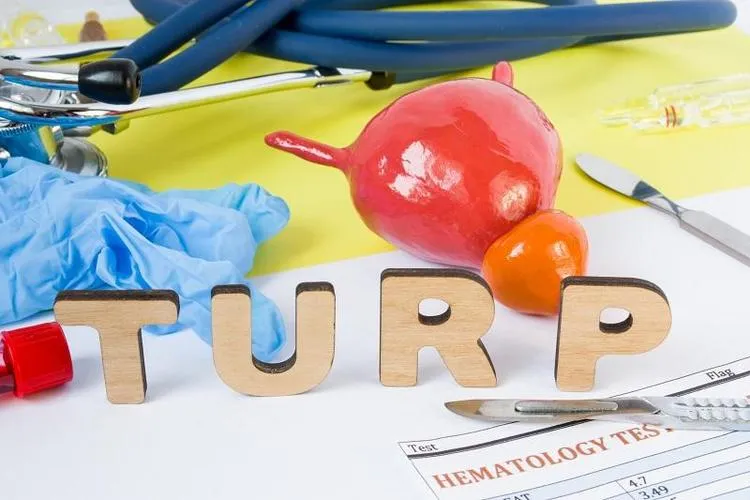At what stage does one require a TURP surgery
June 22, 2022
A Transurethral Resection of the Prostate (TURP) procedure can treat urinary obstruction caused by an enlarged prostate. Benign Prostatic Hyperplasia (BPH) obstructs the urethra, and this operation eliminates the section of the prostate gland that surrounds it.
Fewer than 10% of men will need surgery for prostate enlargement, which occurs in most men. The TURP operation, a curative surgery for prostate cancer, only removes the prostate's urethra-facing sections while leaving the rest of it intact. A resectoscope is put into the penis, through the urethra, and into the prostate during the surgery. Using an electrically activated wire loop, the resectoscope cuts away the adjacent prostate tissue once positioned correctly in the urethra. There is no need for a skin incision for this surgery.
Most men with an enlarged prostate can benefit from medication, but for some, it may not be enough to alleviate symptoms such as poor urine flow. As a man who suffers from BPH, you have several surgical alternatives to consider.
Questions you should ask before the surgery
- Is there a good probability that my health will improve shortly? Exactly how much better will it be?
- How likely is it that a treatment will have adverse effects?
- Are the effects lasting?
- How many times will I need this treatment?
Doctors can now perform minimally invasive operations using tiny cuts (incisions) or tube-style tools inserted into the patient. While less intrusive surgical methods can't treat symptoms as effectively or for as long, these less invasive procedures are easier to recover from, cause less pain, and carry fewer risks.
This type of surgery may be required many times. What's best for you and your doctor depends on your situation. When treating patients with moderate to severe symptoms, doctors can perform these minimally invasive treatments endoscopically or through open surgery. If testing demonstrates that your urination ability is severely impaired, these procedures are also used.
Benign Prostate Hyperplasia (BPH)
Benign Prostate Hyperplasia (BPH) is a non-cancerous growth of the prostate gland in men over 50. The urethra (the tube via which urine flows from the bladder to the penis) is surrounded by the prostate, making urinating difficult. Medications can be tried first, but if they don't work, Transurethral Resection of the Prostate might be necessary.
The male reproductive system includes the prostate gland. Milky fluid, a component of semen, is produced and stored by this organ. The prostate is located between the bladder and the rectum. The urethra is a tube that it encircles. The urethra is the passageway through which urine leaves the body.
When should you go for the surgery?
An enlarged, non-cancerous prostate needs a TURP procedure. Benign prostatic hyperplasia is the medical term for this condition. BPH is characterised by an enlarging prostate that pressures the urethra and the bladder. The natural flow of urine can be hampered by pressure. To enhance the flow of urine, a TURP might be performed.
Men with prostate cancer may also benefit from a TURP procedure. If the doctor feels that removing the prostate in its entirety is too dangerous, this procedure may be used. TURP can also alleviate the symptoms of a blocked urinary tract.
Process Involved
It will be necessary to utilise a specialised scope, which resembles a long, thin tube with a light at the end. The scope will be inserted into the bladder through the opening at the tip of the penis, where urine exits the male organ. Afterwards, the bladder will be filled with a liquid. Using this method, the doctor will be able to view the inside of your body more clearly.
The scope is used to examine the prostate gland. The scope will be implanted with a little surgical tool. A portion of the enlarged prostate will be removed with this tool. There will be a catheter inserted into the bladder. The catheter will let urine drain out as the wound heals. Additionally, a catheter may flush the bladder and eliminate blood clots.
After the surgery
Three weeks should be enough for a patient to after recovering from surgery. You may have symptoms such as uncomfortable or frequent urination for some time. During the first six weeks, they should start to go down. Drink a few glasses of water if you see blood in your pee. The bleeding should stop the next time you urinate.
Consult your physician if this does not occur. Having sex should not be affected in any way by the operation. Retrograde ejaculation is likely after the surgery.
If your doctor advises TURP, go for well-equipped, world-class medical facilities such as Apollo Spectra Hospitals.
Conclusion
Transurethral resection of the prostate is performed to clear urinary obstruction, usually caused by an enlarged prostate. Very few men require surgery for prostate enlargement. Moreover, nowadays, these surgeries can be performed with minimally invasive tools to get better results. So, one should consider undergoing this procedure to get rid of an enlarged, non-cancerous prostate.
Request an appointment at Apollo Spectra Hospitals, Call 18605002244
The time taken to perform TURP varies on how much of the prostate has to be taken out. However, on average, it takes nearly one hour.
It usually takes about three or four weeks to recover after TURP. However, the doctor themselves will recommend the best time to return to normal activities.
NOTICE BOARD
CONTACT US
CONTACT US
 Book Appointment
Book Appointment


.svg)
.svg)
.svg)
.svg)








